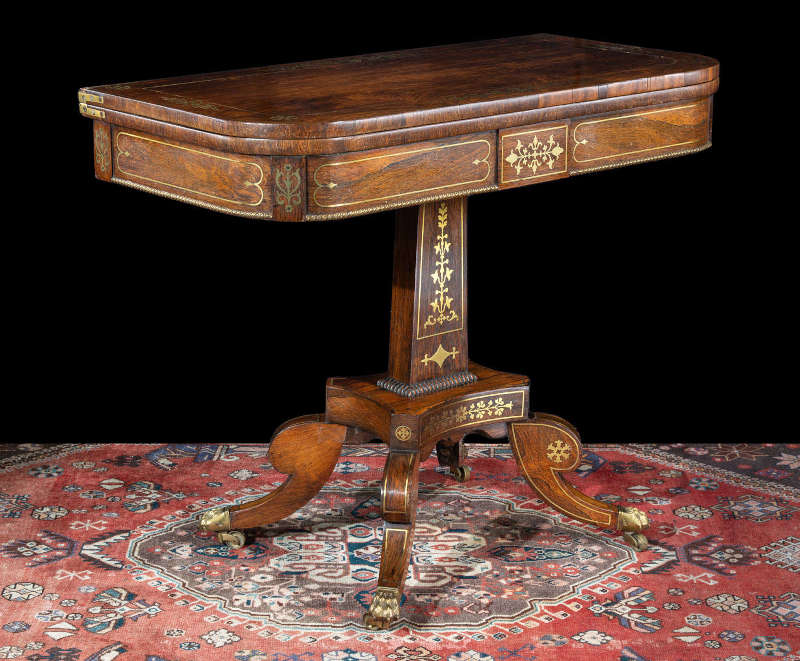The Regency style embodies many of the features of the Neoclassical style
The Regency Style refers to decorative arts created during the Regency period and the reign of King George IV. This is a relatively short period spanning from 1811 to 1830.
The Regency style grew from the Neoclassical style, introduced by the popularity of the Grand Tour, which had dominated the early Georgian period in various forms. As such, the Regency style embodies many of the features of the Neoclassical style, borrowing elements from Greek and Roman antiquity.
The style would take on many other influences besides the classical throughout the period, including Egyptian motifs from the French Imperial style and Indian and Chinese elements.
The history of the Regency style
Georgian architecture is still celebrated, with famous examples including Somerset House in London
The Regency style is named after its progenitor, the regent himself, George IV. George IV took over as regent when his father, King George III, was deemed unfit to rule in 1811. King George IV would take the throne upon his predecessor’s death in 1820.
The Regency era was characterised by the Prince Regent and his lavish lifestyle. George IV would act as a tastemaker for Britain’s aristocracy in a way never before seen.
His grand tastes and patronage of proponents of particular styles would encourage the reemergence of the Rococo style and the adoption of the French Empire style and Indian styles by British architects and also interior designers. There was therefore a profound impact on Regency style interiors.
Regency architecture
The Regency style would evolve to draw in elements from many different styles
Regency architecture adhered to the symmetry and exact proportions of the neoclassical style. Space was carefully used when designing the fronts of buildings to convey a sense of grandeur reminiscent of the art of Greek and Roman antiquity.
However, Regency architecture also indulged in more elaborate features such as curved windows, ornate wrought iron railing, classical friezes and collonaded walkways.
The Regency style would evolve to draw in elements from many different styles, such as the Gothic and international influences such as Indian and Chinese architecture. This created an exuberant take on the typical Neoclassical style that had dominated British design for the last half-century.
The eclectic nature of the Regency architecture can be seen in the Brighton Pavilion, which architect John Nash turned into the Royal Pavilion for George IV. Indian-inspired domes and minarets adorn the exterior of the pavilion.
Inspired by the Prince Regent’s tastes and the cultural stimulation of the Grand Tour, Britain’s aristocracy adopted the Regency style in its various forms for their country estates. The style would be widely disseminated in the form of the country house.
Britain’s newly prospering middle classes would adopt the Regency style as their interest in decorative arts grew.
Regency antiques
The Regency style is often best expressed in the furniture and ornaments of the period
Regency antiques draw upon many of the same stylistic influences as Regency antiques. A characteristic feature of Regency design was the integration of architecture, interior design, and furniture. As such, the Regency style is often best expressed in the furniture and ornaments of the period.

× 
Regency furniture tends to use exotic woods such as rosewood or zebra wood. The intricate brass inlay is also characteristic of Regency furniture.
Similarly, the use of animal features was widespread in the Regency era. Using brass animal heads on chair arms or lion’s paw feet was common, as seen on the card table.
Thomas Hope, George Smith, and Thomas Sheraton would all publish designs for Regency-style furniture. The Prince Regent commissioned both Smith and Hope to design furniture for the Royal Pavilion at Brighton.
Chinese and Indian decorative arts strongly inspired the furniture for the Brighton Pavilion. Imitation bamboo was used extensively in the furniture designs, as well as black and gold lacquering in imitation of East Asian lacquer work.
It is in the Brighton Pavilion that the varied and changing tastes of the Prince Regent can be seen. His adoption of East Asian decorative arts alongside baroque and Neoclassical elements demonstrates the broad scope of the Regency Style.

× 
The expansive scope of the Regency England style can also be seen in these mahogany Regency hall chairs from our collection. The use of mahogany is in keeping with the use of exotic wood in Regency era furniture.
Similarly, the chair backs with the scrolls are reminiscent of forms from Greek and Roman antiquity. However, the arched Italianate style of the chair backs offers a different interpretation of these classical forms to the clean lines and symmetrical feel of much furniture in Regency interiors.
Aftermath
It mixed with Art Deco elements to create a distinct Regency Revival Style
The Regency style, with its flamboyance and expansive scope, was in many ways a reflection of King George IV and his regency.
It would eventually give way to the Victorian style, which was heavily influenced by the Gothic Revival.
The Regency Style would not fade entirely, though and saw a revival in the 1920s and 30s, where it mixed with Art Deco elements to create a distinct Regency Revival Style.
Summary: What are Regency style antiques?
We hope you’ve found this article helpful in understanding more about Regency style antiques. We have a wide range in our collection if you’re looking to purchase Regency furniture or fireplaces.
If you’d like to learn more about decorative styles and design, check out our articles: What is the Wiliam Kent Style? and the history of interior design: a journey through time.
If you have any queries or would like to enquire about anything we have in stock, please contact us.